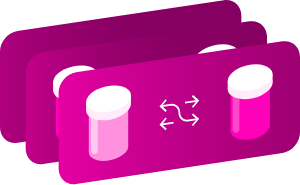This drug entry is astuband has not been fully annotated. It is scheduled to be annotated soon.
Identification
- Generic Name
- Pilsicainide
- DrugBank Accession Number
- DB12712
- Background
-
Pilsicainide has been investigated for the treatment of Paroxysmal Atrial Fibrillation.
- Type
- Small Molecule
- Groups
- Investigational
- Structure
- Weight
-
Average: 272.392
Monoisotopic: 272.188863401 - Chemical Formula
- C17H24N2O
- Synonyms
-
- Pilsicainida
- Pilsicainide
- Pilsicaïnide
- Pilsicainidum
- Pilzicainide
Pharmacology
- Indication
-
Not Available
 Reduce drug development failure ratesBuild, train, & validate machine-learning models
Reduce drug development failure ratesBuild, train, & validate machine-learning models
with evidence-based and structured datasets.Build, train, & validate predictive machine-learning models with structured datasets. - Contraindications & Blackbox Warnings
-
 Avoid life-threatening adverse drug eventsImprove clinical decision support with information oncontraindications & blackbox warnings, population restrictions, harmful risks, & more.Avoid life-threatening adverse drug events & improve clinical decision support.
Avoid life-threatening adverse drug eventsImprove clinical decision support with information oncontraindications & blackbox warnings, population restrictions, harmful risks, & more.Avoid life-threatening adverse drug events & improve clinical decision support. - Pharmacodynamics
-
Not Available
- Mechanism of action
- Not Available
- Absorption
-
Not Available
- Volume of distribution
-
Not Available
- Protein binding
-
Not Available
- Metabolism
- Not Available
- Route of elimination
-
Not Available
- Half-life
-
Not Available
- Clearance
-
Not Available
- Adverse Effects
-
 Improve decision support & research outcomesWith structured adverse effects data, including:blackbox warnings, adverse reactions, warning & precautions, & incidence rates.Improve decision support & research outcomes with our structured adverse effects data.
Improve decision support & research outcomesWith structured adverse effects data, including:blackbox warnings, adverse reactions, warning & precautions, & incidence rates.Improve decision support & research outcomes with our structured adverse effects data. - Toxicity
-
Not Available
- Pathways
- Not Available
- Pharmacogenomic Effects/ADRsBrowse all" title="" id="snp-actions-info" class="drug-info-popup" href="javascript:void(0);">
- Not Available
Interactions
- Drug InteractionsLearn More" title="" id="structured-interactions-info" class="drug-info-popup" href="javascript:void(0);">
-
This information should not be interpreted without the help of a healthcare provider. If you believe you are experiencing an interaction, contact a healthcare provider immediately. The absence of an interaction does not necessarily mean no interactions exist.
Drug Interaction Integrate drug-drug
interactions in your softwareAcebutolol Acebutolol may increase the arrhythmogenic activities of Pilsicainide. Acetyldigitoxin Acetyldigitoxin may increase the arrhythmogenic activities of Pilsicainide. Acrivastine The risk or severity of QTc prolongation can be increased when Acrivastine is combined with Pilsicainide. Adenosine Adenosine may increase the arrhythmogenic activities of Pilsicainide. Ajmaline Ajmaline may increase the arrhythmogenic activities of Pilsicainide. Alfuzosin The risk or severity of QTc prolongation can be increased when Alfuzosin is combined with Pilsicainide. Alimemazine The risk or severity of QTc prolongation can be increased when Alimemazine is combined with Pilsicainide. Amantadine The risk or severity of QTc prolongation can be increased when Amantadine is combined with Pilsicainide. Amifampridine The risk or severity of QTc prolongation can be increased when Pilsicainide is combined with Amifampridine. Amiodarone The risk or severity of adverse effects can be increased when Amiodarone is combined with Pilsicainide.  Identify potential medication risksEasily compare up to 40 drugs with our drug interaction checker.Get severity rating, description, and management advice.Learn more
Identify potential medication risksEasily compare up to 40 drugs with our drug interaction checker.Get severity rating, description, and management advice.Learn more - Food Interactions
- Not Available
Products
-
 Drug product information from 10+ global regions我们的数据集提供批准的产品信息including:
Drug product information from 10+ global regions我们的数据集提供批准的产品信息including:
dosage, form, labeller, route of administration, and marketing period.Access drug product information from over 10 global regions. - Product Ingredients
-
Ingredient UNII CAS InChI Key Pilsicainide hydrochloride 03C8I9296V 88069-49-2 NZOSVDHCTCLGEB-UHFFFAOYSA-N - International/Other Brands
- Sunrythm
Categories
- Drug Categories
- Chemical TaxonomyProvided byClassyfire
-
- Description
- This compound belongs to the class of organic compounds known as beta amino acids and derivatives. These are amino acids having a (-NH2) group attached to the beta carbon atom.
- Kingdom
- Organic compounds
- Super Class
- Organic acids and derivatives
- Class
- Carboxylic acids and derivatives
- Sub Class
- Amino acids, peptides, and analogues
- Direct Parent
- Beta amino acids and derivatives
- Alternative Parents
- Anilides/m-Xylenes/Pyrrolizidines/N-arylamides/N-alkylpyrrolidines/Trialkylamines/Secondary carboxylic acid amides/Azacyclic compounds/Organopnictogen compounds/Organic oxides show 2 more
- Substituents
- Amine/Anilide/Aromatic heteropolycyclic compound/Azacycle/Benzenoid/Beta amino acid or derivatives/Carbonyl group/Carboxamide group/Hydrocarbon derivative/M-xylene show 16 more
- Molecular Framework
- Aromatic heteropolycyclic compounds
- External Descriptors
- Not Available
- Affected organisms
- Not Available
Chemical Identifiers
- UNII
- AV0X7V6CSE
- CAS number
- 88069-67-4
- InChI Key
- BCQTVJKBTWGHCX-UHFFFAOYSA-N
- InChI
-
InChI=1S/C17H24N2O/c1-13-6-3-7-14(2)16(13)18-15(20)12-17-8-4-10-19(17)11-5-9-17/h3,6-7H,4-5,8-12H2,1-2H3,(H,18,20)
- IUPAC Name
-
N-(2,6-dimethylphenyl)-2-(hexahydro-1H-pyrrolizin-7a-yl)acetamide
- SMILES
-
CC1=CC=CC(C)=C1NC(=O)CC12CCCN1CCC2
References
- 一般引用
- Not Available
- External Links
-
- KEGG Drug
- D08377
- PubChem Compound
- 4820
- PubChem Substance
- 347828910
- ChemSpider
- 4654
- BindingDB
- 50413638
- ChEBI
- 135127
- ChEMBL
- CHEMBL163238
- ZINC
- ZINC000049925459
- Wikipedia
- Pilsicainide
Clinical Trials
- Clinical TrialsLearn More" title="" id="clinical-trials-info" class="drug-info-popup" href="javascript:void(0);">
-
Phase Status Purpose Conditions Count Not Available Unknown Status Treatment Paroxysmal Atrial Fibrillation (PAF) 1
Pharmacoeconomics
- Manufacturers
-
Not Available
- Packagers
-
Not Available
- Dosage Forms
- Not Available
- Prices
- Not Available
- Patents
- Not Available
Properties
- State
- Not Available
- Experimental Properties
- Not Available
- Predicted Properties
-
Property Value Source Water Solubility 0.389 mg/mL ALOGPS logP 2.36 ALOGPS logP 3.16 Chemaxon logS -2.8 ALOGPS pKa (Strongest Acidic) 14.44 Chemaxon pKa (Strongest Basic) 10.46 Chemaxon Physiological Charge 1 Chemaxon Hydrogen Acceptor Count 2 Chemaxon Hydrogen Donor Count 1 Chemaxon Polar Surface Area 32.34 Å2 Chemaxon Rotatable Bond Count 3 Chemaxon Refractivity 83.77 m3·mol-1 Chemaxon Polarizability 31.16 Å3 Chemaxon Number of Rings 3 Chemaxon Bioavailability 1 Chemaxon Rule of Five Yes Chemaxon Ghose Filter Yes Chemaxon Veber's Rule Yes Chemaxon MDDR-like规则 No Chemaxon - Predicted ADMET Features
- Not Available
Spectra
- Mass Spec (NIST)
- Not Available
- Spectra
-
Spectrum Spectrum Type Splash Key Predicted MS/MS Spectrum - 10V, Positive (Annotated) Predicted LC-MS/MS Not Available Predicted MS/MS Spectrum - 20V, Positive (Annotated) Predicted LC-MS/MS Not Available Predicted MS/MS Spectrum - 40V, Positive (Annotated) Predicted LC-MS/MS Not Available Predicted MS/MS Spectrum - 10V, Negative (Annotated) Predicted LC-MS/MS Not Available Predicted MS/MS Spectrum - 20V, Negative (Annotated) Predicted LC-MS/MS Not Available Predicted MS/MS Spectrum - 40V, Negative (Annotated) Predicted LC-MS/MS Not Available
Transporters
- Kind
- Protein
- Organism
- Humans
- Pharmacological action
-
No
- Actions
-
Substrate
- General Function
- Transporter activity
- Specific Function
- Involved in the ATP-dependent secretion of bile salts into the canaliculus of hepatocytes.
- Gene Name
- ABCB11
- Uniprot ID
- O95342
- Uniprot Name
- Bile salt export pump
- 分子量
- 146405.83 Da
References
- Pedersen JM, Matsson P, Bergstrom CA, Hoogstraate J, Noren A, LeCluyse EL, Artursson P: Early identification of clinically relevant drug interactions with the human bile salt export pump (BSEP/ABCB11). Toxicol Sci. 2013 Dec;136(2):328-43. doi: 10.1093/toxsci/kft197. Epub 2013 Sep 6. [Article]
Drug created at October 20, 2016 23:45 / Updated at February 21, 2021 18:53




